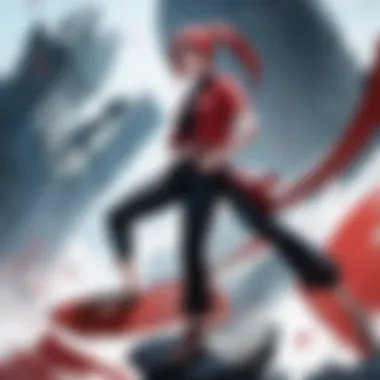Exploring 'Naruto Movie 5': A Comprehensive Analysis


Intro
The fifth installment in the Naruto film franchise, titled Naruto: Blood Prison, serves as a defined marker in the series. This film expands on the mythos present in the anime, revealing more about the characters and the world they inhabit. With a runtime of 108 minutes, it presents a tightly woven narrative that engages viewers on multiple levels. This article will explore various facets of this movie—from character profiles to thematic explorations—offering a comprehensive overview that resonates with both die-hard fans and those who are newly introduced to the Naruto universe.
Character Profiles
Overview of Main Characters
Naruto: Blood Prison introduces a variety of characters, each contributing to an intricate narrative tapestry. The protagonist, Naruto Uzumaki, remains central, displaying his typical resolve and innocence while navigating his imprisonment. His interactions illustrate both personal growth and the overarching theme of redemption that permeates the film.
Another pivotal character is the antagonist, Kijō, the warden of the prison. His motivations are complex, and his character acts as a foil to Naruto. Kijō’s journey from villainy to understanding enhances the narrative depth and raises questions about justice and retribution.
Additionally, characters such as Kakashi Hatake and Sakura Haruno play significant supporting roles. Their presence adds layers to Naruto's journey, emphasizing themes of camaraderie and support.
Supporting Characters
The supporting cast introduces several notable figures. Yūgao Uzuki emerges as a strong ally, showcasing the themes of loyalty and friendship. She embodies the trust that underpins Naruto’s bond with his peers, while also presenting a counterbalance to Kijō’s malice.
The side characters enrich the storytelling, providing snippets of humor and heart amidst the serious tones. For instance, minor characters witness the main events, reflecting the impact of Naruto’s actions on the larger community.
Theme Exploration
Central Themes
Naruto: Blood Prison addresses significant themes such as redemption, justice, and the struggle against isolation. The film illustrates Naruto’s fight not merely against external foes, but also against his own feelings of alienation. The prison serves as a metaphor for societal rejection, showcasing how collateral damage arises from misunderstanding and fear.
"The film poignantly addresses the impact of societal roles and expectations on an individual's identity."
Cultural References
The movie draws upon various cultural references that resonate with audiences familiar with Japanese folklore and societal norms. Themes of honor and loyalty feature prominently, echoing Japan's historical narratives and traditional values. Such references deepen the viewer's engagement, urging them to reflect on both the narrative and its broader implications in society.
Popular Series and Recommendations
Top Anime Series of the Year
Fans of Naruto: Blood Prison might also find interest in other top anime series released around the same time, such as:
- Attack on Titan
- My Hero Academia
- Demon Slayer
These series offer rich narratives and complex characters, similar to the depth found in Naruto’s cinematic experience.
Hidden Gems in Manga
For those delving into manga, several hidden gems capture the essence of storytelling found in Naruto. Some recommendations include:
- Dragon Ball Super
- Blue Exorcist
- The Promised Neverland
These titles exemplify engaging storytelling that resonates well beyond mere entertainment, providing deeper reflections on growth and adversity.
Overview of Naruto Movie
The importance of this section lies in setting the stage for the entire exploration of Naruto Movie 5, also known as Naruto: Blood Prison. Understanding its release context and core narrative helps readers appreciate the movie's significance within the Naruto franchise. This section delves into two critical elements: the title and release information, and the synopsis of the plot. Through these topics, we can grasp not only the fundamental storyline but also the reactions it provoked among fans and critics.
Title and Release Information
Naruto: Blood Prison was released in Japan on July 30, 2011. It is the fifth installment in the Naruto film series, taking place during the timeline of the anime series. Directed by Masahiko Murata, the film presents a fresh angle on themes such as betrayal and redemption. Notably, this movie was produced during the final arcs of the original Naruto series, which contributes to its thematic resonance. The film enjoys a running time of approximately 108 minutes, allowing for a compact yet engaging narrative that aligns well within the broader storyline of the series.
Upon its release, Naruto: Blood Prison gained considerable attention for its action sequences and emotional depth, appealing to the existing fanbase while attracting newcomers to the franchise.


Synopsis of the Plot
The plot centers around Naruto Uzumaki, who is unjustly imprisoned within the Blood Prison, a facility known for housing some of the most dangerous criminals. Here, he encounters not only friends but also formidable foes and faces challenges that test his resolve. The main antagonist, Buryo, aims to manipulate Naruto’s chakra for his own gain, leading to a confrontation that serves both physical and emotional arcs. This storyline explores Naruto's desire for freedom and his struggle to maintain his identity amid extreme adversity.
Through unexpected alliances and revelations about his past, Naruto demonstrates resilience and determination. The experience within Blood Prison becomes a pivotal moment in his growth and enforces the significance of friendships and loyalty amidst betrayal.
"Naruto's journey in Blood Prison showcases the transformative power of friendship and the quest for personal identity, setting the stage for significant character development."
This overview serves as a foundation to analyze Naruto Movie 5 through a variety of lenses including themes, character developments, animation techniques, and its cultural impact—elements that underline its worth in the vast Naruto universe.
Key Themes in Naruto Movie
Understanding the key themes of Naruto Movie 5 is essential for appreciating its depth. The film, titled Naruto: Blood Prison, explores themes that resonate with many viewers. It provides a canvas to reflect on significant human experiences such as redemption, friendship, and the struggle for identity. Each of these themes contributes uniquely to the narrative and character development, making them crucial for a thorough analysis.
The Concept of Redemption
Redemption stands at the forefront of the narrative in Naruto: Blood Prison. It is not just about seeking forgiveness but also about the transformative journey individuals undergo. The film's protagonist, Naruto Uzumaki, finds himself in dire straits, accused of a crime he did not commit. His quest for redemption involves proving his innocence while also understanding the nuances of trust and betrayal.
The theme is illustrated through the character arcs of both Naruto and the antagonists. Each character's path reflects personal growth or downfall, serving as a mirror to the audience's own experiences with redemption. The overarching message is clear: redemption is possible, but it often requires sacrifice and perseverance.
Friendship and Loyalty
Friendship and loyalty are indispensable themes woven throughout this movie. The dynamics between Naruto, Sasuke Uchiha, and Sakura Haruno highlight these concepts. Naruto’s unwavering loyalty to his friends propels much of the plot. His relationships serve as a foundation in navigating the complex moral situations he faces.
Sasuke's character portrays a contrasting perspective on loyalty, emphasizing moments of internal conflict. His bond with Naruto exemplifies the struggle between personal ambitions and the commitment to friendships. Through these character interactions, the film emphasizes that true loyalty sometimes entails difficult choices.
The Struggle for Identity
The struggle for identity permeates the storyline of Naruto: Blood Prison. Many characters grapple with their past and the roles they play in their current lives. Naruto, known for his rebellious nature, often faces judgment based on preconceived notions. The film allows viewers to witness his confrontation with personal doubts and societal labels.
This theme extends beyond Naruto, affecting supporting characters as well. Each character’s journey toward understanding who they truly are adds complexity to the narrative. Their struggles reflect a universal human experience, making it relatable to the audience. The film invites audiences to ponder their identities and the factors shaping them.
"Identity is not just a label but a journey of understanding one’s self and choices."
Character Analysis
Character analysis is essential to understand the narrative and thematic structure of any film, particularly in 'Naruto Movie 5'. The depth of individual characters often reflects broader themes and influences viewer emotions. In this movie, characters serve not just as individuals but as representations of larger concepts such as redemption, friendship, and conflict. Thus, analyzing characters helps us to decipher the film’s messages and emotional core.
Naruto Uzumaki's Growth
Naruto Uzumaki’s growth throughout this movie is substantial. His character embodies resilience and determination. In 'Blood Prison', we witness Naruto facing external challenges and internal conflicts. He grapples with feelings of isolation and the burden of expectations. This growth is crucial for the audience as it highlights his transformation from a brash child into a more mature and aware shinobi. By the end, he showcases significant emotional depth, revealing more nuanced traits.
Supporting Characters and Their Roles
Supporting characters play a significant role in enhancing the main themes of the movie. Each character brings unique elements to the story, underscoring the importance of teamwork and loyalty.
Sasuke Uchiha
Sasuke Uchiha adds complexity to the narrative. His character is often defined by his struggles with revenge and identity. In this film, Sasuke emerges as a protector of Naruto, highlighting themes of friendship and loyalty. His key characteristic is his determination to evolve beyond his past, making him a compelling choice for character analysis. The unique feature is his evolution alongside Naruto. This aspect provides depth to their relationship while displaying a contrast between vengeance and camaraderie. Analyzing Sasuke’s contributions shows how he complements Naruto’s journey.
Sakura Haruno
Sakura Haruno serves as a strong influence on Naruto’s emotional state. Her steadfastness and growth reflect the care and compassion that shape the narrative. Sakura’s key characteristic is her determination to support her friends, making her a sympathetic figure in the story. The unique aspect of her character is her dual role as a healer and a fighter, which provides a balance within the team dynamic. Analyzing her contributions reveals how vital emotional support is in overcoming challenges in their journey.
Kakashi Hatake
Kakashi Hatake’s character represents wisdom and experience. His role as a mentor underscores the importance of guidance and growth. His key characteristic is his calm demeanor, which contrasts with the more emotional characters. This characteristic is vital for the article as it offers insight into leadership within the narrative. The unique feature of Kakashi is his ability to adapt his teaching methods to suit his students' needs. He serves as a pivotal character in smoothing the tumultuous dynamics among the group. Understanding Kakashi’s contributions can illuminate how mentorship plays a role in the development of other characters.
Antagonists in the Narrative
Antagonists in 'Naruto Movie 5' serve not only to create conflict but also to challenge the protagonists’ growth. They embody the fears and struggles that Naruto and his friends must confront. Understanding these characters offers insight into what motivates the heroes and illustrates the painterly way obstacles are presented in confronting one's inner demons.


Conflict is the essence of storytelling, and in this case, the antagonists provide direct opposition, forcing the heroes to evolve in meaningful ways.
Animation and Art Style
The animation and art style of Naruto Movie 5, known as Naruto: Blood Prison, plays a critical role in how the story is delivered and perceived by the audience. Attention to detail in the visual presentation not only enhances the storytelling but also evokes strong emotional responses from viewers. The significance of animation transcends mere aesthetics; it is integral to character portrayal, action sequences, and the overall mood of the film. Analyzing the animation techniques used lends insight into their effect on the narrative's depth and the audience's engagement.
Visual Aesthetics
The visual aesthetics of Naruto: Blood Prison stand out prominently. The color palette and character designs reflect the unique style of the Naruto franchise. The film utilizes a bright yet balanced color scheme that complements the various emotional tones across different scenes. Each character has a distinctive design that resonates with their backstory and personality traits. For instance, Naruto Uzumaki is typically illustrated with vibrant colors representing his energetic and bold character while characters like Gaara, who have darker themes, often bear a more muted color scheme.
Key aspects of visual aesthetics include:
- Character Design: Each character's look is meticulously crafted to mirror their development.
- Backgrounds: Richly detailed settings enhance the immersive environment, contributing to the film's world-building.
- Symbolism: Visual elements often contain layers of meaning, adding depth to the narrative.
These components collectively foster a sense of realism, drawing viewers deeper into the Naruto universe.
Choreography of Fight Scenes
The choreography of fight scenes in Naruto: Blood Prison showcases the complexity and creativity that the series is known for. This movie features fights that blend physical skill with strategic thinking, making them not only visually stimulating but narratively significant as well. The choreography respects the established fighting styles of characters while also introducing new and dynamic moves. Each action sequence is awarded business and narrative weight, enhancing the stakes of confrontations.
Factors contributing to effective fight choreography include:
- Fluid Animation: Smooth transitions between movements maintain the energy of the fight.
- Camera Angles: Strategic camera work captures the essence of each interaction, providing perspective on the intensity of battles.
- Timely Music Integration: Sound design and music heighten the atmosphere, adding to the emotional impact of the scenes.
Overall, the careful execution of animation and choreography elevates Naruto: Blood Prison, making it a visual feast that complements its rich storytelling.
Cultural Impact of Naruto Movie
The cultural impact of Naruto Movie 5: Blood Prison extends beyond mere entertainment. It reflects significant themes that resonate with audiences, illuminating values relevant to both Japanese and global contexts. The movie enhances the long-standing legacy of the Naruto franchise, motivating discussions about its themes and character developments.
Reception Among Fans
The reception of Blood Prison among fans has been noteworthy. Many viewers praised the film for its exploration of complex emotions and relationships. The portrayal of struggles faced by Naruto and his companions attracted both admiration and introspection. Fans took to platforms like Reddit and Facebook to express their views. Here are some key points from fan reception:
- Engagement with Characters: Fans invested in the characters highlighted their growth throughout the narrative. This investment strengthened the bond between the audience and the series.
- Thematic Depth: Themes such as redemption and loyalty sparked debate among fans on forums. The narrative allowed fans to reflect on personal relationships in their lives.
- Artistic Achievements: The animation quality also received acclaim. Viewers recognized how the visual aesthetics complemented the story’s emotional weight, enhancing the overall experience.
Overall, fans of the Naruto series embraced the film as a worthwhile addition to the franchise, further solidifying the community’s dedication.
Critics' Perspectives
Critics offered a diverse range of opinions regarding Naruto Movie 5. Many reviews acknowledged the film’s ambition in addressing significant themes. Some highlighted the following aspects:
- Narrative Structure: Critics often remarked on the coherence of the plot. The balance between fast-paced action and emotional depth was a particular focus, with many praising it as engaging.
- Character Exploration: The film’s take on character arcs was seen as an evolution from previous movies. Critics noted how it deepened understanding of motivations and conflicts.
- Cultural Relevance: The movie was also analyzed for its cultural context, with some critics suggesting that it touches on contemporary issues faced by youth globally. This perspective brought a new layer of appreciation to the film.
"Naruto Movie 5 resonates with audiences because it encapsulates the journey of self-discovery amidst external challenges."
This attention to thematic elements showcased the movie’s potential significance beyond the anime community. Critics acknowledged this film’s role in sparking discussions about resilience and identity.
In summary, Naruto Movie 5: Blood Prison stands as a cultural artifact, enriching conversations among fans and critics alike. Its impact manages to bridge gaps, highlighting universal themes while remaining grounded in its unique narrative tradition.
Music and Sound Design
Music and sound design are critical components of Naruto Movie 5, also known as Naruto: Blood Prison. The auditory elements enhance the emotional tone of scenes, shaping viewer experiences and responses. Effective sound design creates an immersive environment, allowing the audience to connect more deeply with characters and narratives. In this movie, both music and sound contribute significantly to the overall storytelling.
Original Soundtrack Overview
The original soundtrack of Naruto: Blood Prison plays an integral role in setting the mood throughout the film. Composed by Yasuharu Takanashi, the music captures various emotions aligned with the plot's developments. From intense action sequences to quieter, reflective moments, the soundtrack adapts to the unfolding drama. Key tracks reinforce crucial scenes, guiding viewer emotions and reactions.
Among the standout pieces, the theme that accompanies Naruto’s moments of struggle and determination resonates strongly. It showcases the character's perseverance as he navigates through adversities. Furthermore, the themes associated with supporting characters add to their development, highlighting their individual journeys within the story.
- Main Themes: Reflect character growth, especially Naruto's progression.
- Unique Sound Elements: Use of traditional Japanese instruments intertwines with modern sounds, enriching the auditory experience.
- Motifs: Recurring musical themes tie back to previous storylines, creating continuity in the franchise.


Overall, the soundtrack isn't merely background music; it acts as an emotional narrative, enhancing the film's impact.
The Role of Sound in Storytelling
Sound design in Naruto: Blood Prison goes beyond mere musical composition. It includes sound effects that help establish the atmosphere and intensity of action scenes. The clashing of weapons, the whoosh of jutsu, and environmental sounds offer a visceral experience, pulling viewers into the action.
These auditory elements are crucial in storytelling as they:
- Build Tension: Heightened sound effects during fights amplify suspense.
- Provide Context: Ambient sounds inform the audience of locations and settings, making scenes feel more grounded.
- Enhance Character Moments: Subtle sound changes can mark significant emotional shifts, guiding viewer interpretation of character relationships and motivations.
"Sound is often overlooked, but it plays a pivotal role in shaping how stories are told in film and animation."
Comparative Analysis with Other Naruto Movies
The importance of comparative analysis with other Naruto movies in this article cannot be understated. Within the Naruto franchise, each film carries its unique nuances, character arcs, and themes. By examining these varying facets, we can not only appreciate Naruto: Blood Prison better but also understand its place within the broader narrative tapestry of the series. This analysis reveals consistent storytelling techniques and distinct character development patterns, allowing us to recognize trends and deviations in character portrayal and narrative structure across the franchise.
Storytelling Techniques
In Naruto: Blood Prison, storytelling unfolds through a prism of intense action and character-driven moments. The movie utilizes various techniques to convey a compelling narrative, including:
- Flashbacks: These are skillfully woven into the plot, providing context and depth to characters' experiences, particularly for Naruto and the antagonists.
- Character Dialogue: Dialogue is used to explore motivations and emotional states, promoting a deeper understanding of the stakes involved.
- Conflict Resolution: The film employs both internal and external conflicts as storytelling devices. Internal struggles, particularly vis-à-vis Naruto's redemption, juxtaposed with physical battles enhance dramatic tension.
These storytelling methods not only keep viewers engaged but also align with techniques observed in other movies from the franchise, contributing to their thematic consistency.
Character Development Patterns
Character development is a crucial aspect of the Naruto films, showcasing growth potential and evolving relationships. In Naruto: Blood Prison, the central character undergoes significant evolution, which resonates with the overall themes of the series.
Key character development patterns observed are:
- Transformation Arcs: Each main character experiences profound changes. For instance, Naruto’s quest for redemption serves as a stark contrast to his earlier portrayal in other films, showcasing a more mature outlook.
- Interpersonal Relationships: The dynamic among Naruto, Sasuke, and Sakura is revisited, allowing exploration of loyalty and friendship. These relationships are multi-layered and affect character decisions throughout the narrative.
- Antagonist Complexity: Unlike more straightforward villains in earlier movies, the antagonists in Blood Prison possess deeper motivations, providing a richer narrative experience. This resonates with the trend of evolving complexity in character design seen in later films, creating a more engaging conflict.
"Character complexity in Naruto films invites viewers to reflect on their own experiences of growth and change," a crucial element that enhances the viewing experience.
Viewer Reception and Legacy
The viewer reception and legacy of Naruto: Blood Prison are pivotal in understanding its place within the broader Naruto franchise. The film’s release sparked significant interest among fans, blending elements of the series with new narratives and character developments. Analyzing how this movie was received can offer insights into its lasting impact and the reasons behind its enduring popularity.
Box Office Performance
Naruto: Blood Prison had a notable performance at the box office, reflecting the franchise's popularity. Released in Japan, the film accumulated substantial earnings during its run. Initial projections indicated a strong attendance, with fans eager to see their favorite characters on the big screen again.
Several factors contributed to its box office success:
- Strong Brand Recognition: The Naruto series has a vast, loyal fanbase. This dedicated audience plays a significant role in driving ticket sales.
- Positive Pre-release Buzz: Marketing strategies, including trailers and promotional events, built anticipation, leading to increased viewership.
- Strong Competition: Despite competing with other animated films, Blood Prison managed to carve its niche, showcasing unique story elements that appealed to the audience.
Overall, the box office performance not only emphasizes the film’s popularity but also solidifies its place in the Naruto franchise. It confirms the interest in continuing stories related to beloved characters and plots.
Long-Term Fan Engagement
Long-term fan engagement for Naruto: Blood Prison illustrates how the film continues to resonate with audiences even years after its release. Various aspects contribute to this ongoing connection:
- Merchandising: The film has spawned numerous figures, collectibles, and other merchandise, keeping the film in the minds of fans.
- Discussion Platforms: Fans regularly engage on forums like Reddit, where they share insights, theories, and nostalgia around the film. These discussions enhance community ties and continue to introduce the film to new viewers.
- Social Media Presence: The film frequently appears on platforms like Facebook and Twitter, where quotes, scenes, and fan art are shared. This social engagement creates a cycle of interest that keeps the film relevant.
In summary, Naruto: Blood Prison has not only succeeded at the box office but also fosters ongoing engagement among fans, creating a lasting legacy within the Naruto universe.
Closure
The conclusion of this comprehensive analysis plays a crucial role in tying together the various threads explored throughout the article. It consolidates key insights gained from dissecting plot elements, character development, and the cultural significance of Naruto: Blood Prison. This section serves as a reflective overview, reminding readers of the movie's importance in the broader context of the Naruto franchise.
Summary of Key Insights
In this film, the concept of redemption emerges prominently through the arcs of Naruto and other characters. The journey encompasses inner battles and the quest for trust and acceptance. The rich animation and carefully orchestrated fight scenes not only entertain but elevate the storytelling. Moreover, the reception among fans and critics alike underscores the film’s role in shaping the ongoing legacy of Naruto, making it a notable entry in the series.
Future of Naruto Continuing the Legacy
As we look ahead, the future of Naruto remains intertwined with its ability to evolve while respecting its roots. New storylines can explore the aftermath of Blood Prison and its themes. The franchise's potential lies in its willingness to adapt and innovate. Future works can build on the foundations laid by this film, diving deeper into identity and relationships. Ultimately, the legacy of Naruto continues, driven by a dedicated fanbase that seeks not only to celebrate but also to expand the narrative beyond its original confines.







